The Roaring 20's
Recommended Reading

|
An Informal History of the 1920's Frederick Lewis Allen Harper and Row, Publishers 1st edition 1931, 2nd edition 1959 ISBN 0-06-08004-6
This book is an attempt to tell, and in some mesaure to interpret, the story of what in the future may be considered a distinct era in American history:
the eleven years between the end of the war with Germany (November 11, 1918) and the stock-market panic which culminated on November 13, 1929, hastening and
dramatizing the destruction of what had been known as Coolidge (and Hoover) Prosperity. . . . It has
seemed to me that one who writes at such close range, while recollection is still fresh, has a special opportunity to record the fads and fashions and follies
of the time, the things which millions of people thought about and talked about and became excited about and which at once touched their daily lives... - F.W. Allen
What can I say, I love this book. It's written in a relaxed, narrative style that really brings the events to life. What makes this book notable is that
it was written in 1931, immediately after the period ended, and thus provides a unique insight into how the era appeared to someone who had just lived
through it. Despite its length (over 300 densly printed pages), I found myself wishing it were longer. There is so much fascinating material covered that
once you've picked it up, you won't want to put it down. Highly recommended.
(This book's writing level is appropriate adult readers as well as high school students and above)
| |
| |
||

|
1919 - 1941 Isabel Leighton, ed. Simon and Schuster, Publishers - 1949, 1959 Amereon, Ltd (date unknown) ISBN 0848816617
This is a story of America between two Wars, told in terms of the most significant, or typical, or utterly fantastic news events of the gaudy and chaotic
years that separated Versailles from Pearl Harbor. . . . We seem to have fluctuated between headaches: sometimes induced by prohibition,
more frequently by the fevered pace of the times. During these throbbing years we searched in vain for a cure-all, coming no closer to it that the aspirin bottle.
hence: The Aspirin Age. . . . Twenty-two prominent authors, all closely connected with the period have written . . . [what] is,
I hope, no mere chronicling of arresting events, but rather a re-creation of a strange and almost simnambulistic time when America was much younger in spirit than
it ever can be again. - Isabel Leighton
Prohibition, Harding and the Teapot Dome scandal, the rise and fall of the Klan, Jack Dempsey, Sacco and Vanzetti, Lindbergh, and the Crash of '29.
These stories, and a bunch more are discussed in detail in this book. This is not so much a broad overview of the period, but a close look at a few of
the era's defining moments. What I like about this book is it covers topics that you probably dryly remember from middle school history class and brings
them to life. For this reason especially, this is a book that's well worth searching out. (This book's writing level is appropriate adult readers as well as junior high/high school students)
| |
| |
||

|
American Culture and Society in the 1920s Lynn Dumenil Hill and Wang, Publishers 1st edition 1995 ISBN 0-8090-1566-8
When most of us take a backward glance at the 1920s, we may think of prohibition and the Jazz Age, of movie stars and flappers, of Harold Lloyd and Mary Pickford, of
Lindbergh and Hoover - and of Black Friday, October 29, 1929, when the plunging stock market ushered in the Great Depression. But the 1920s were much more, ... a dramatic, important, and misunderstood decade [during which] changing
values brought an end to the repressive Victorian era; urban liberalism emerged; the federal bureaucracy was expanded, pluralism became increasingly important to America's
heterogeneous society; and different religious, ethnic, and cultural groups encountered the homogenizing force of a powerful mass-consumer culture.
This book takes a fresh look at the drastic change that American culture underwent during the 1920s, looking at the era in a new perspective. This book is a well researched,
in-depth scholarly volume that I would recommend for readers who wish to look beyond flappers and speakeasies to see the real changes that America underwent in the 1920s.
(Given the writing level and postulatory content, I would only recommend this book for college level readers and above.)
| |
| |
||

|
Mongrel Manhattan in the 1920s Ann Douglas Farrar, Straus and Giroux - 1st edition 1995 The Noonday Press - 2nd edition 1996 ISBN 0-374-52462-9
Terrible Honesty is a portrait of the soul of a generation, the story of the men and women who made New York the capitol of American
literature, music, and thater in the 1920s. In a strikingly original interpretation that brings tthe Jazz Age to life in a enw way, Ann Douglas
shows how "Mongrel Manhattan" was at the heart of a daring and accomplished historical transformation: blacks and whites, men and
women together created a new American culture, espousing the new mass media, repudiating the euphemisms of outdated gentility in favor of a
boldly masculinized "terrible honesty," bringing the African-American folk and popular art heritage irrevocably into the mainstream.
In a nutshell, this book explores the emergence of a new black culture, indeed a new American culture, from out of Harlem during the 1920s.
This text pays particular attention to the various forces that were in play in shaping the new culture as well as delving into the people and
relationships that made the Harlem Renaissance what it was.
(Given the writing level, I would only recommend this book for college level readers and above.)
| |
| |
||
|
This site is maintained by Alex Hajnal |